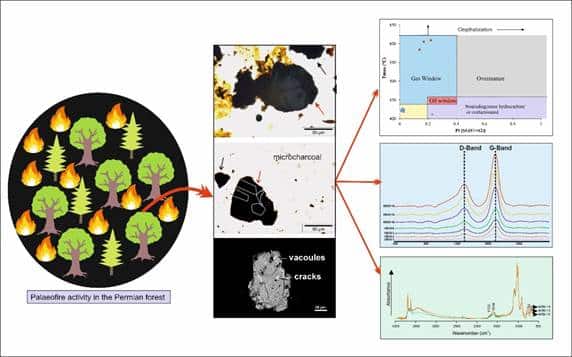Research Explores Fire History in Permian India

In a groundbreaking study, scientists have uncovered a remarkable archive of ancient wildfires in the Godavari Basin of peninsular India. Utilizing advanced microscopic techniques and chemical analysis, researchers from the Birbal Sahni Institute of Palaeosciences have traced the remnants of these palaeofires, which date back approximately 250 million years to the Permian period. Their findings promise to reshape our understanding of Earth’s geological and climatic history, revealing the profound impact of ancient fires on ecosystems and carbon storage.
Unveiling the Past: The Significance of Palaeofires
The research focuses on the Late Silurian to Quaternary periods, highlighting how palaeofires influenced vegetation, climate, and coal formation. Previous studies had identified macroscopic charcoal in coal-bearing formations across Gondwana, indicating widespread wildfires. The Raniganj Coalfield in India was one of the first locations where fossil charcoal was discovered, linking ancient mire systems to seasonal drought-induced fires. While high atmospheric oxygen levels during the Permian may have intensified these events, the exact nature of these fires remained ambiguous. Researchers struggled to determine whether the charcoal found was a result of local fires or if it had been transported by wind or water.
Methodology: A Deep Dive into Geological Analysis
To unravel the mystery of these ancient fires, the research team conducted a detailed analysis of shale samples from the Godavari Basin. These fine-grained sedimentary rocks are rich in organic material, providing a wealth of information about past environmental conditions. The scientists employed palynofacies analysis to categorize tiny particles of organic matter preserved within the rock. Among these particles were translucent organic matter, palaeofire-induced charcoal, and oxidized charcoal, which may have been transported or altered after burning.
Led by Dr. Neha Aggarwal, the team utilized advanced techniques such as Raman Spectroscopy, Rock-Eval Pyrolysis, and FTIR Spectroscopy to decode the fire history embedded in these ancient rocks. Their study, published in the journal ACS Omega, marks a significant advancement in palaeofire research by clearly differentiating between in situ (on-site) and ex situ (transported) charcoal.
Key Findings: Stratigraphy and Environmental Shifts
One of the most notable findings of the study is the influence of stratigraphy on charcoal deposition. The researchers observed that during regressive phases, when sea levels dropped, well-preserved fire signatures were found. Conversely, during transgressive phases, when sea levels rose, the charcoal appeared more mixed and oxidized. This suggests dynamic environmental shifts during the Permian period, providing valuable insights into how ancient ecosystems responded to changing conditions.
Understanding the transformation of organic matter during palaeofires is crucial for grasping long-term carbon storage in Earth’s crust. This knowledge holds significant implications for carbon sequestration, a vital strategy in addressing contemporary climate change. Furthermore, the research offers geologists a refined perspective on interpreting past ecosystems, vegetation changes, and fire dynamics, enhancing palaeoclimate reconstructions and geological dating techniques.
Implications for Future Research and Climate Understanding
The findings from this study not only deepen our understanding of ancient wildfires but also provide essential tools for modern climate science. By revealing how palaeofires influenced carbon storage and ecosystem dynamics, researchers can better assess the implications of fire activity in the context of current climate change challenges. The insights gained from the Godavari Basin research could pave the way for future studies aimed at understanding the complex interplay between fire, vegetation, and climate throughout Earth’s history.
Observer Voice is the one stop site for National, International news, Sports, Editor’s Choice, Art/culture contents, Quotes and much more. We also cover historical contents. Historical contents includes World History, Indian History, and what happened today. The website also covers Entertainment across the India and World.

